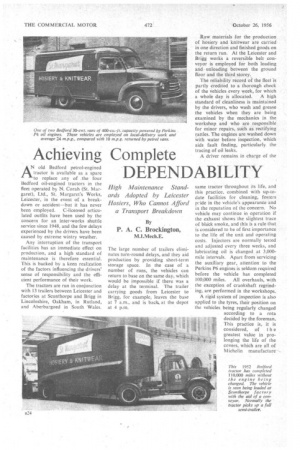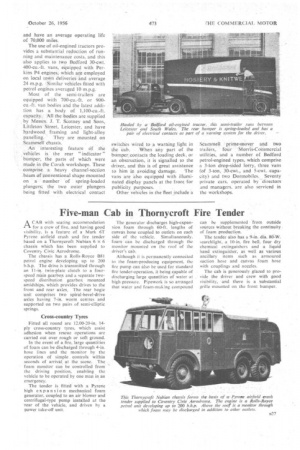Achieving Complete DEPENDABILITY
Page 58

Page 61

If you've noticed an error in this article please click here to report it so we can fix it.
By
P. A. C. Brockington,
M.I.Mech.E. AN old Bedford petrol-engined tractor is available as a spare . to replace any of the four Bedford oil-engined tractors in the fleet operated by N. Corah (St. Margaret), Ltd., St. Margaret's Works, Leicester, in the event of a breakdown or accident—but it has never been employed. C-licensed articulated outfits have been used by the concern for an inter-works shuttle service since 1948, and the few delays experienced by the drivers have been caused by extreme wintry weather.
Any interruption of the transport facilities has an immediate effect on production, and a high standard of maintenance is therefore essential. This is backed by a keen realization of the factors influencing the drivers' sense of responsibility and the efficient performance of their work.
The tractors are run in conjunction with 13 trailers between Leicester and factories at Scunthorpe and Brigg in Lincolnshire, Oakham, in Rutland, and Aberbargoed in South Wales. The large number of trailers eliminates turn-round delays, and they aid production by providing short-term storage space. In the case of a number of runs, the vehicles can return to base on the same day, which would be impossible if there was a delay at the terminal. The trailer carrying goods from Leicester to Brigg, for example, leaves the base at 7 a.m., and is back, at the depot at 4 p.m.
Raw materials for the production of hosiery and knitwear are carried in one direction and finished goods on the return run. At the Leicester and Brigg works a reversible belt conveyor is employed for both loading and• unloading between the ground floor and the third storey.,
The reliability record of the fleet is partly credited to a thorough check of the vehicles every week, for which a whole day is allocated. A high standard of cleanliness is maintained by the drivers, who wash and grease the vehicles when they are being examined by the mechanics in the workshop and who are responsible for minor repairs, such as rectifying rattles. The engines are washed down with water before inspection, which aids fault finding, particularly the tracing of oil leaks.
A driver remains in charge of the same tractor throughout its life, and this practice, combined with up-todate facilities for cleaning, fosters pride in the vehicle's appearance and in the reputation of the concern. No vehicle may continue in operation if the exhaust shows the slightest trace of bla".ck smoke, and this is a rule that is considered to be of first importance to the life of the unit and operating
costs. Injectors are normally tested and adjusted every three weeks, and lubricating oil is changed at 3,000mile intervals. Apart from 'servicing the auxiliary gear, attention to the Perkins P6 engines is seldom required before the vehicle has completed
100,000 miles. All overhauls, with the exception of crankshaft regrinding, are performed in the workshops.
A rigid system of inspection is also applied to the tyres, their position on the vehicles being regularly changed according to a rota decided by the foreman. This practice is, it is considered, of t h a greatest value in prolonging the life of the covers, which are all of Michelin manufacture and have an average operating life of 70,000 miles.
The use of oil-ertgined tractors provides a substantial reduction of running and maintenance costs. and this also applies to two Bedford 30-cwt. 400-cu.-ft. vans, equipped with Perkins P4 engines, which are employed on local town deliveries and average 24 m.p.g. Similar vehicles fitted with petrol engines averaged 10 rn.p.g.
Most of the semi-trailers are equipped with 700-cu.-ft. or 900cu.-ft. van bodies and the latest addition has a body of 1..,100-cu.4t. capacity. All the bodies are supplied by Messrs. J, T. Scotney and Sons, Littleton Street, Leicester, and have hardwood framing and light-alloy panelling. They are mounted on Scamn-tell chassis.
An interesting feature df the 'vehicles is the rear " indicator " bumper, the parts of which were made. in the Corah workshops. These comprise •a heavy channel-section .beam of conventionalshape mounted on a number of spring-loaded plungers; the two outer plungers being fitted with electrical contact switches wired. to-.a warning light in
the cab. When any part of (he bumper, contacts the loading deck, or an obstruttion, it is signalled to the driver, and this is of great assistance
to him in avoiding -damage. The vans are also equipped with illuminated display panels at the front for publicity purposes.
Other vehicles in the fleet include a
Scammell prime-mover and two trailers, four MorriS-Commercial utilities, and a number of Bedford petrol-engined types, which comprise a 3-ton drop-sided lorry, three vans (of 3-ton. 30-cwt., and 5-cwt. capacity) and two Dormobiles._. Seventy private cars. operated by directors and managers, are also serviced in the workshops.




































































































